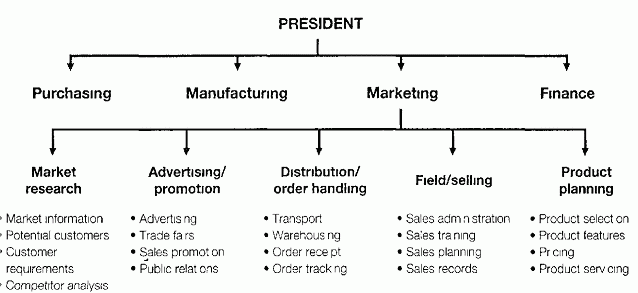Organisation of the Marketing department
Category: Marketing
Organisational structure
The organisation of the marketing department must allow the following objectives to be reached:
efficient coordination of all marketing activities
sufficient flexibility to respond quickly to changes in the market place
adequate ability to produce new ideas and motivate the organisation to challenge traditional beliefs
permanent provision of the right mix of specialisation in marketing tasks and product and market knowledge
Traditionally marketing departments were organised in functional sub-departments
Traditional organisation of marketing departments
As companies grew, however, these organisational structures proved not to be flexible enough. Different products might be sold on different markets thus requiring special marketing attention. Therefore companies started to reorganise their structure (sub-system for industrial product groups) in order to regain flexibility and reduce its difficulties in coordination with process.
Normal evolution of flexibility/coordination with processes when companies are growing
Distribution Manufacturing Market research
The product manager is responsible for all the activities relating to his product.
The product manager acts as a entrepreneur for his or her product group. The ideal product manager must have the following characteristics:
entrepreneur al thinking
excellent initiative
creativity
willing to become an expert for the product group and its market?? able to sell ideas and convince others
willing to cooperate with all processes of relevance for the product
group and act as coordinator
have clear vision for the product group
able to communicate with the market
Product management
Product management means the performance of a specific product group in the market place can be closely monitored. This makes it possible to avoid having a marketing department that focuses only on a few best-liked products.
Further benefits of product management are listed below:
specific know-how is acquired about all aspects of a product group?? new product development is better oriented towards market requirements
activities within the firm which concern the product group can be executed much more quickly (fewer people involved in decisions)
a cost-effective marketing mix for the product group can be developed
changes n the market place which are relevant for the product group will be recognised and acted upon immediately
product group specific controlling can be introduced much more easily
someone is responsible for the profit generated by the product
group
Product management organisation of marketing departments
More authority and no collision of interest
Product management on the other hand has the disadvantage that similar tasks have to be fulfilled by each of the company’s product management units. Therefore similar know-how is built up at different points.
To make use of both marketing and product know how modern companies establish a matrix organisation. It should combine product and marketing know-how in a flat hierarchy that s flexible towards market requirements. The ability of product managers and functional managers to communicate with each other is crucial for the success of a matrix organisation.
Matrix organisation of marketing departments
Links with business processes
The image of a company communicated on the market place by the marketing department must be positive the image of a successful company Therefore marketing has to be interlinked with all business processes.
A business process is a collection of activities within the company aimed at creating value for the customer on the market place.
Most organisations are made up of six core business processes:
— Product development: following a new idea for a product through to the prototyping stage
— Customer engagement process: from the stage of targeting a customer through to achieving a proposal for delivering a product or service
— Customer acquisition: ranging from preparing a proposal to obtaining contractual commitment
— Order fulfillment: from receiving the order to obtaining payment
— Service: from receiving a customer enquiry to answering it
— Manufacturing: from procurement to shipping
All business processes and the activities they consist of are ultimately aimed at serving the customer. The business recognises the needs of the customers and acts upon them.
The business process
Marketing is the link between the customer and the company
Marketing is interlinked with all core processes It is the link between the customer and the company and therefore plays a vital role in providing essential information to both sides.
To think in process terms instead of in strict functional hierarchies will provide significant benefits:
• Flexibility for change
Avoidance of bureaucratic hierarchies with multiple decision making steps these are inherently resistant to change
• Closeness to the real world
Process orientation brings managers closer to customers operations technology and the workforce
• Ownership of processes
Someone feels responsible for the underlying processes and is in charge of optimising them to best serve the customer







